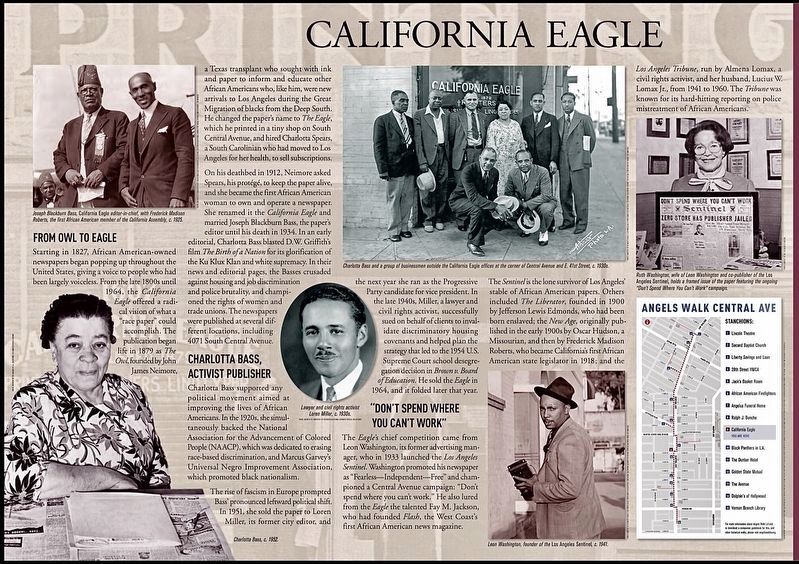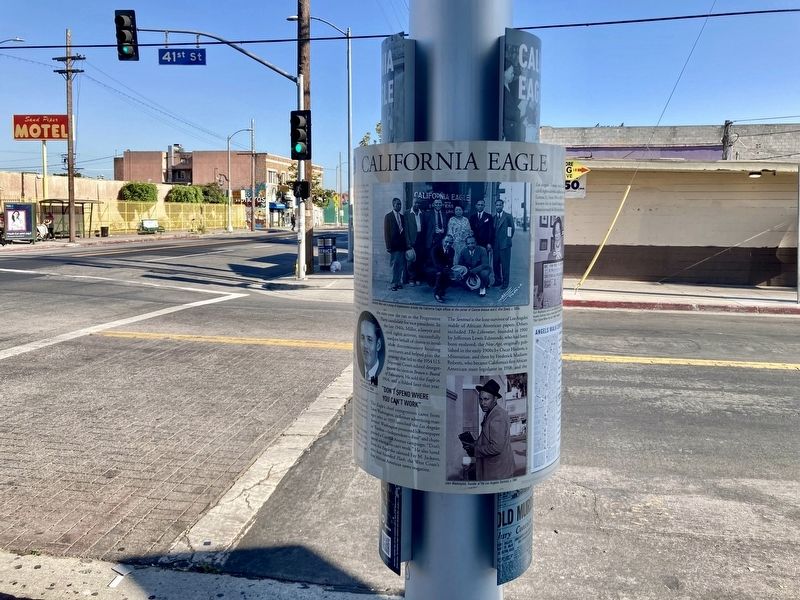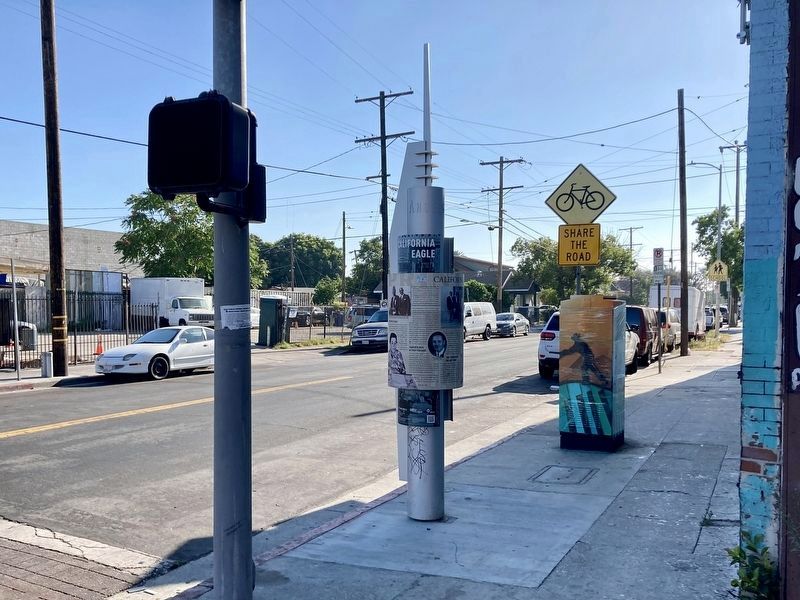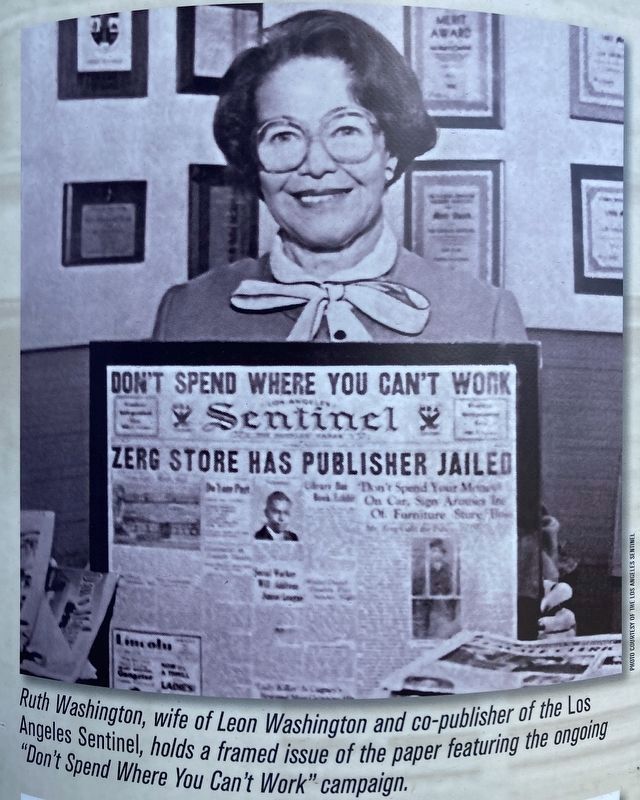South Los Angeles in Los Angeles County, California — The American West (Pacific Coastal)
California Eagle
From Owl to Eagle
Starting in 1827, African American-owned newspapers began popping up throughout the United States, giving a voice to people who had been largely voiceless. From the late 1800s until 1964, the California Eagle offered a radical vision of what a "race paper" could accomplish. The publication began life in 1879 as The Owl founded by John James Neimore, a Texas transplant who sought with ink and paper to inform and educate other African Americans who, like him, were new arrivals to Los Angeles during the Great Migration of blacks from the Deep South. He changed the paper's name to The Eagle, which he printed in a tiny shop on South Central Avenue, and hired Charloeta Spears, a South Carolinian who had moved to Los Angeles for her health, to sell subscriptions.
On his deathbed in 1912, Neimore asked Spears, his protégé, to keep the paper alive, and she became the first African American woman to own and operate a newspaper. She renamed it the California Eagle and married Joseph Blackburn Bass, the papers editor until his death in 1934. In an early editorial, Charlotta Bass blasted D.W. Griffith's film The Birth of a Nation for its glorification of the Ku Klux Klan and white supremacy. In their news and editorial pages, the Basses crusaded against housing and job discrimination and police brutality, and championed the rights of women and trade unions. The newspapers were published at several different locations, including 4071 South Central Avenue.
Charlotta Bass, Activist Publisher
Chartorta Bass supported any political movement aimed at improving the lives of African Americans. In the 1920s, she simultaneously backed the National Association for the Advancement of Colored People (NAACP), which was dedicated to erasing race-based discrimination, and Marcus Garvey's Universal Negro Improvement Association, which promoted black nationalism.
The rise of fascism in Europe prompted Bass’ pronounced leftward political shift. In 1951, she sold the paper to Loren i Miller, its former city editor, and the next year she ran as the Progressive Party candidate for vice president. In the late 1940s, Miller, a lawyer and civil rights activist, successfully sued on behalf of clients to invalidate discriminatory housing covenants and helped plan the strategy that led to the 1954 U.S. Supreme Court school desegregation decision in Brown v. Board of Education. He sold the Eagle in 1964, and it folded later that year.
"Don’t Spend Where You Can’t Work"
The Eagle's competition came from Leon Washington, its former advertising manager, who in 1933 launched the Los Angeles Sentinel. Washington promoted his newspaper as "Fearless—Independent-Free" and championed a Central Avenue campaign: "Don't spend where you can't work." He also lured from the Eagle the talented Fay M. Jackson, who had founded Flash, the West Coast's first African American news magazine.
The Sentinel is the lone survivor of Los Angeles’ stable of African American papers. Others included The Libentter, founded in 1900 by Jefferson Lewis Edmonds, who had been born enslaved; the New Age, originally published in the early 1900s by Oscar Hudson, a Missourian, and then by Frederick Madison Roberts, who became California's first African American state legislator in 1918; and the Los Angeles Tribune, run by Almena Lomax, a civil rights activist, and her husband, Lucius W. Lomax Jr., from 1941 to 1960. The Tribune was known for its hard-hitting reporting on police mistreatment of African Americans.
Erected 2020 by City of Los Angeles.
Topics. This historical marker is listed in these topic lists: African Americans • Civil Rights • Communications • Industry & Commerce. A significant historical year for this entry is 1879.
Location. 34° 0.566′ N, 118° 15.4′ W. Marker is in Los Angeles, California, in Los Angeles County. It is in South Los Angeles. Marker is at the intersection of 41st Street and Central Avenue, on the right when traveling west on 41st Street. Touch for map. Marker is at or near this postal address: 4071 S Central Ave, Los Angeles CA 90011, United States of America. Touch for directions.
Other nearby markers. At least 8 other markers are within walking distance of this marker. Black Panthers in L.A. (within shouting distance of this marker); Ralph J. Bunche (about 300 feet away, measured in a direct line); Florence Mills Theatre (about 700 feet away); The Downbeat Club (about 700 feet away); Dunbar Hotel (approx. 0.2 miles away); Ralph Bunche Home (approx. 0.2 miles away); Angelus Funeral Home (approx. 0.2 miles away); The Elks Club (approx. 0.2 miles away). Touch for a list and map of all markers in Los Angeles.
Related marker. Click here for another marker that is related to this marker. - the Los Angeles Sentinel.
Also see . . . Angeles Walk L.A. Self-guided walking tours of historic neighborhoods in Los Angeles. The California Eagle marker is part of the Central Avenue walk. (Submitted on July 26, 2023.)
Credits. This page was last revised on July 26, 2023. It was originally submitted on July 26, 2023, by Craig Baker of Sylmar, California. This page has been viewed 101 times since then and 46 times this year. Photos: 1, 2, 3, 4. submitted on July 26, 2023, by Craig Baker of Sylmar, California.



